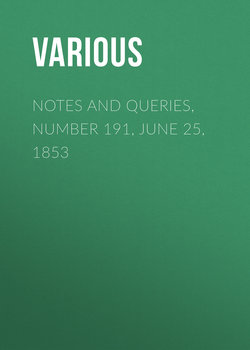Читать книгу Notes and Queries, Number 191, June 25, 1853 - Various - Страница 7
Queries
Оглавление"MERK LANDS" AND "URES."—NORWEGIAN ANTIQUITIES
In Shetland, at the present day, all public assessments are levied, and divisions made, according to the number of merk lands in a parish. All arable lands were anciently, under the Norwegian law, rated as merks,—a merk containing eight ures. These merks are quite indefinite as to extent. It is, indeed, clear that the ancient denomination of merk land had not reference to superficial extent of surface, but was a denomination of value alone, in which was included the proportion of the surrounding commonty or scattald. Merk lands are of different values, as sixpenny, ninepenny, twelvepenny,—a twelvepenny merk having, formerly at least, been considered equal to two sixpenny merks; and in some old deeds lands are described as thirty merks sixpenny, otherwise fifteen merks twelvepenny land. All assessments have, however, for a very long period, been levied and all privileges apportioned, according to merks, without relation to whether they were sixpenny or twelvepenny. The ancient rentals of Shetland contain about fourteen thousand merks of land; and it will be noticed that, however much the ancient inclosed land be increased by additional improvements, the number of merks ought to be, and are, stationary. The valued rent, divided according the merk lands, would make a merk land in Shetland equal to 2l. Scots of valued rent. There are only one or two places of Scotland proper where merks are in use,—Stirling and Dunfermline, I think. As these two places were the occasional residences of our ancient Scottish kings, it is possible this plan of estimating land may have obtained there, to equalise and make better understood some arrangements relating to land entered into between the kings of Norway and Scotland. Possibly some of the correspondents of "N. & Q." in the north may be able to throw some light on this subject. It was stated some time ago that Dr. Munch, Professor in the University of Christiana, had presented to the Society of Northern Archæology, in Copenhagen, a very curious manuscript which he had discovered and purchased during a voyage to the Orkneys and Shetland in 1850. The manuscript is said to be in good preservation, and the form of the characters assigns the tenth, or perhaps the ninth century as its date. It is said to contain, in the Latin tongue, several episodes of Norwegian history, relating to important facts hitherto unknown, and which throw much light on feudal tenures, holdings, superstitions, omens, &c., which have been handed down to our day, with their origin involved in obscurity, and on the darkness of the centuries that preceded the introduction of Christianity into Norway. Has this manuscript ever been printed?
Kirkwallensis.
THE LEIGH PEERAGE, AND STONELEY ESTATES, WARWICKSHIRE
The fifth Lord Leigh left his estates to his sister, the Hon. Mary Leigh, for her life, and at her decease without issue to "the first and nearest of his kindred, being male, and of his name and blood," &c. On the death of Mrs. Mary Leigh in 1806, the estates were taken possession of by her very distant kinsman, the Rev. Thomas Leigh. The first person to dispute his right to them was Mr. George Smith Leigh, who claimed them as being descended from a daughter of Sir Thomas Leigh, son of the first Baron Leigh. His claim was not allowed, because he had the name of Leigh only by royal license, and not by inheritance. Subsequently, the Barony of Leigh was claimed by another Mr. George Leigh, of Lancashire, as descended from a son of the Hon. Christopher Leigh (fourth son of the aforesaid Sir Thomas Leigh), by his second wife. His claim was disallowed when heard by a committee of the House of Lords in 1828, because he could not prove the second marriage of Christopher Leigh, nor the birth of any son by such marriage.
